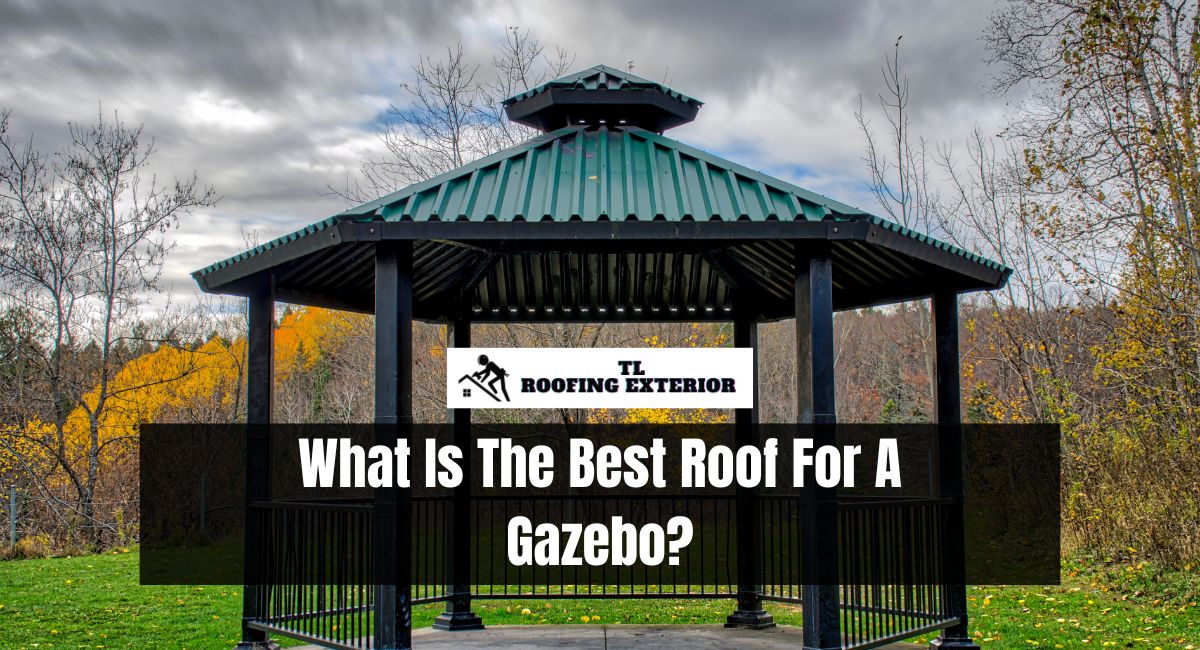A gazebo is a charming centerpiece for any outdoor area. It’s a place to relax, hang out with friends, or even be alone. Even though the design and materials of the gazebo itself are important, the roof is the most important part because it determines how well it works and how nice it looks.
Choosing the best roof for your gazebo can be hard since you can use anything from traditional shingles to modern metal.
In this piece, we’ll look at the different types of roofing and compare their pros and cons to help you choose the best one for your needs and tastes.
What Is The Best Roof For A Gazebo?
The best roof for a gazebo depends on various factors, including climate, aesthetics, budget, and maintenance requirements. Here are some popular roofing options for gazebos, along with their pros and cons:
1. Asphalt Shingles
Pros:
- Affordability: One of the most cost-effective options, making it accessible for many homeowners.
- Ease of Installation: Asphalt shingles are lightweight and easy to install, often requiring less structural support.
- Variety: Comes in a range of colors and styles, allowing you to match the gazebo with your home or garden theme.
Cons:
- Durability: Generally lasts 15-30 years, less than other options.
- Weather Sensitivity: Can be damaged by extreme weather conditions like high winds or heavy snow.
Best For: Those on a budget still want various aesthetic choices. Ideal for mild climates.
2. Cedar Shingles or Shakes
Pros:
- Aesthetic Appeal: Offers a timeless, rustic look that ages gracefully.
- Weather Resistance: Cedar is naturally resistant to moisture and insect damage.
- Longevity: With proper maintenance, it can last up to 40 years.
Cons:
- Maintenance: Requires regular treatment to prevent moss, mildew, and decay.
- Cost: Generally more expensive than asphalt shingles.
Best For: Homeowners looking for a natural, rustic look are willing to invest in initial cost and ongoing maintenance.
3. Metal Roofing
Pros:
- Longevity: Can last up to 50 years or more with minimal maintenance.
- Weather Resistance: Excellent for extreme weather conditions, including heavy snow and high winds.
- Low Maintenance: Requires very little upkeep once installed.
Cons:
- Noise: Rainfall can be loud on a metal roof, which some people find disruptive.
- Initial Cost: More expensive upfront, although it can be cost-effective over the long term due to its durability.
Best For: Those living in areas with extreme weather who want a durable, low-maintenance option.
4. Polycarbonate Panels
Pros:
- Light Transmission: Allows natural light to filter through, creating a bright and inviting space.
- Lightweight: Easier to install and requires less structural support compared to heavier materials.
- Weather Resistance: Generally resistant to both high winds and heavy snow.
Cons:
- Aesthetic Limitations: It may not offer the natural or traditional look that some homeowners prefer.
- Discoloration: Can be yellow over time due to UV exposure.
Best For: Those who want a modern look and a bright interior space in their gazebo.
5. Slate Tiles
Pros:
- Extreme Durability: Can last up to 100 years or more.
- Elegance: Offers a high-end, classic look that adds value to your property.
- Fire Resistance: Naturally fire-resistant, adding an extra layer of safety.
Cons:
- Weight: Very heavy, often requiring additional structural support.
- Cost: One of the most expensive roofing options available.
Best For: Those looking for a luxurious, long-lasting option and willing to invest in additional structural support.
6. Thatched Roof
Pros:
- Unique Look: Provides an exotic, tropical aesthetic that stands out.
- Natural Insulation: Offers good thermal insulation, keeping the gazebo cool in summer and warm in winter.
Cons:
- Short Lifespan: Generally needs to be replaced every 4-6 years.
- Fire Risk: Not fire-resistant and may require additional treatments to improve safety.
Best For: Those looking for a unique, eye-catching design and willing to invest in frequent replacements and maintenance.
7. Clay or Ceramic Tiles
Pros:
- Longevity: Can last 50 years or more with proper maintenance.
- Classic Appeal: Offers a Mediterranean or Spanish look that can be very attractive.
Cons:
- Weight: Like slate, clay tiles are heavy and may require additional structural support.
- Cost: High initial cost, although durability can make it cost-effective over the long term.
Best For: Those seeking a classic, Mediterranean, or Spanish aesthetic and willing to invest in a durable, long-lasting option.
When selecting a roofing material for your gazebo, you must consider the initial cost and the long-term maintenance, durability, and how well it will complement your existing landscape or architecture. Professional consultation can provide valuable insight into what will work best for your particular requirements.
Conclusion
Consider a number of factors, such as durability, maintenance, esthetic appeal, and cost, when choosing the finest roof for your gazebo. Whether you choose the natural beauty of cedar shingles, the minimal maintenance of metal, or the cost-effectiveness of asphalt, the key is to select a roofing material that aligns with your lifestyle and climate conditions.
You can ensure that the roof of your gazebo not only enhances its appearance but also stands the test of time.
